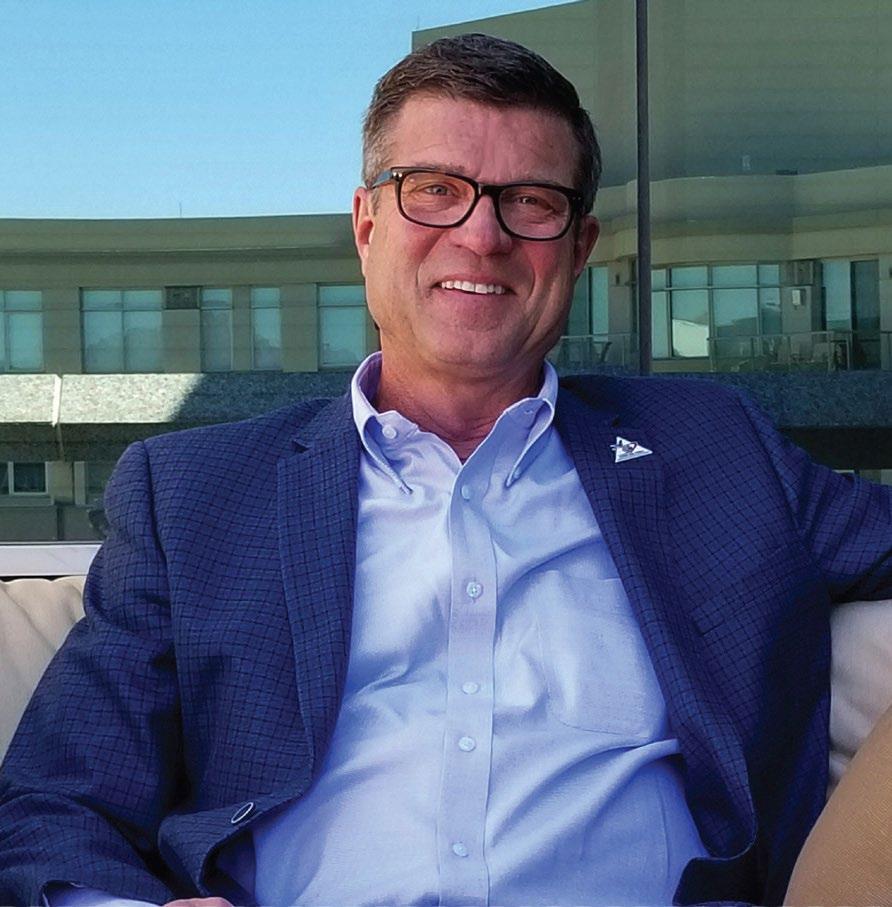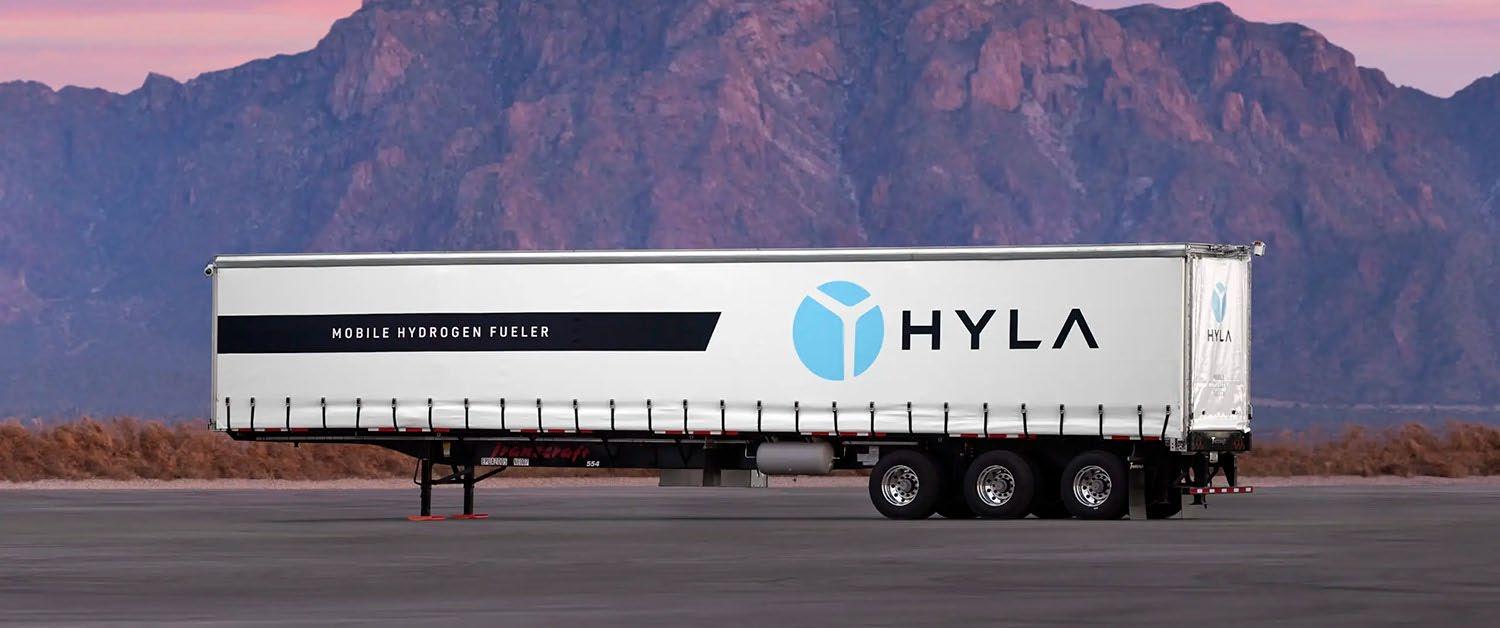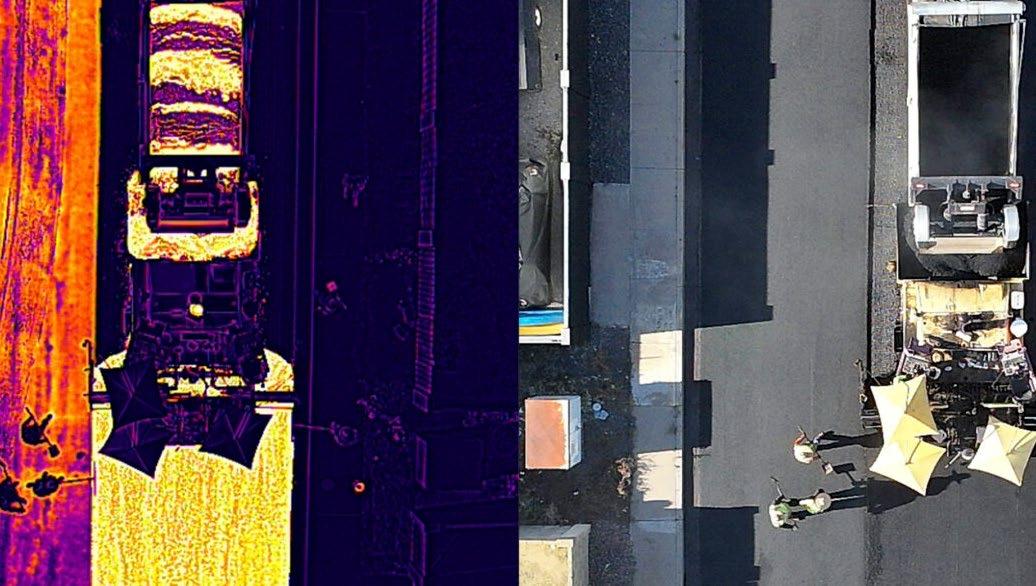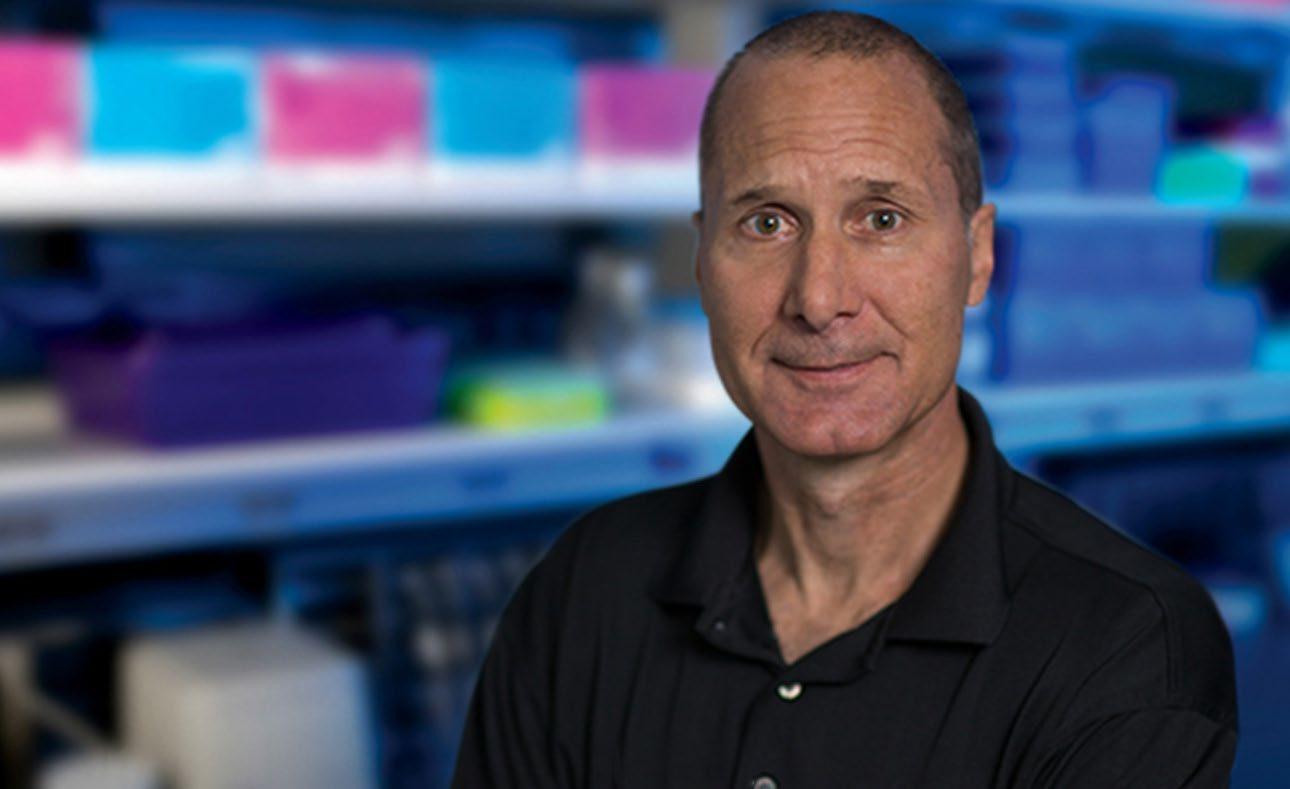










Something big, bold and exciting is happening in the Grand Canyon state. Cutting-edge companies are launching, testing and scaling new technologies in Arizona. Our culture of innovation, highly skilled talent pool, lean regulatory environment, and affordable operating costs provide the perfect platform for business growth and success. Beyond being a place where you can achieve your professional goals, Arizona also provides a lifestyle that allows you to achieve your personal goals. With year-round sunshine, endless outdoor activities, and a positive outlook, we play as hard as we work. It’s this perfect balance that makes life better here.

IN THIS ISSUE
The Power of Going Electric
Publisher’s Letter
An Electrifying Move Forward Vehicle fleet conversion part of carbon neutrality plan
Life in the Fast Lane Electric vehicles are finding an open road in Arizona
An Intelligent Infrastructure Systems engineers look to enhance traffic safety with technology 01 02 03 05 08 11 12
Power Trip
Companies focus on ways to keep electric vehicles moving down the road
Paving Precision
Navigating the path to pavement quality control supports mobility
Winning Scores
High longevity tallies reflect both long life and health
Single Knockout Blow
New therapy enlists body’s immune system to eliminate melanoma


SUMMER 2024
PUBLISHERS
Sandra Watson
Steven G. Zylstra
EDITOR
Don Rodriguez
EXECUTIVE
EDITORIAL DIRECTOR
Alyssa Tufts
MAGAZINE DESIGNED BY:
CREATIVE DIRECTOR Maddie Santiago
EMAIL techconnect@aztechcouncil.org
For queries or customer service, call 602-343-8324
View more of TechConnect: aztechcouncil.org/techconnect
TechConnect is published by the Arizona Technology Council, 2800 N. Central Ave. #1530, Phoenix, AZ 85004
Entire contents copyright 2023, Arizona Technology Council. Reproduction in whole or in part without permission is prohibited. Products named in these page pages are trade names or trademarks of their respective companies. Publication of TechConnect is supported by the Arizona Commerce Authority.
Publisher’s Letter

It never ceases to amaze me just how powerful we all can be when we unite for a common cause.
A prime example in recent years is the move toward electric vehicles. At the Arizona Technology Council, we have seen growing interest in this field that is more commonly known simply as e-mobility.
Our membership has welcomed new types of companies in this sector whose profiles likely would have been considered low-key at best a decade ago. To support them, the Council launched the Arizona E-Mobility & Energy Ecosystem (AEEE) Committee, whose mission is to work collaboratively to ensure uniform integration and standards of four key areas in electrification: zero-emission vehicles, charging and refueling, battery manufacturing and life cycle, and energy infrastructure.
To prepare the workforce to support these types of companies and others are training programs known as Future48 Workforce Accelerators overseen by the Arizona Commerce Authority (ACA) in coordination with higher education and industry partners. ACA is our publishing partner of TechConnect.
We both also have teamed up in bringing the expanding e-mobility ecosystem and others together to share ideas and best practices. With the support of ACA, the Council and its AEEE Committee recently staged our second annual E-mobility and Clean Energy Summit. One panel—Zero Emission Infrastructure in Arizona—featured representatives from local utilities and government agencies who shared the progress being made in building out the infrastructure.

The shot in the arm for our annual summit—the first was a sellout!—came when President Joe Biden signed the Infrastructure Investment and Jobs Act (IIJA) in November 2021. In particular, the IIJA gave life to an electric vehicle charging program in the U.S. with funding of up to $5 billion over five years for the National Electric Vehicle Infrastructure (NEVI) Formula Program, as well as making various charging and refueling competitive grants available at a value of up to $2.5 billion over five years.
We’re not alone in our interest to ensure e-mobility has the fuel to keep going here. The Arizona Department of Transportation has launched its own Electric Vehicle Infrastructure Deployment Plan as part of NEVI, which requires states to meet strict specifications in their electric vehicle plans and networks in order to qualify for the funds.
During the five years of the NEVI program, Arizona is set to receive $76.5 million in federal dollars to establish publicly accessible electric charging stations along the state’s alternative fuel corridors, which are currently the interstate highways. The department plans to add highways to the network as it updates its annual electric vehicle plan.
There is even more happening when it comes to activities focused on the state’s roads. You will find some of those stories on the pages that follow.
Expect more progress to come as we work together to fast-track Arizona’s place in e-mobility.

Vehicle fleet conversion part of carbon neutrality plan
BY CECILE LEBLANC
If you are on Northern Arizona University’s Flagstaff campus, you might see one of the new electric utility vehicles (EUV) zipping off to one building or another.
A little bigger than golf carts but more rugged, these EUVs are workhorses carrying NAU’s Facility Service’s carpentry and general maintenance crew and their equipment around campus, explains Stephanie Bauer, associate vice president of facility and maintenance. “Each day our technicians travel all over campus responding to urgent and critical work requests, as well as work on planned projects,” Bauer says.
The EUVs are also playing a part in helping NAU reach its goal of carbon neutrality by 2030.
To work toward this goal, NAU sustainability staff and students developed a Climate Action Plan (CAP) outlining steps the university should take. The CAP outlines expectations of gradually integrating more electric vehicles into NAU’s fleet as gas vehicles need replacing.
Bauer says Facility Services is looking to replace approximately 90 gas vehicles remaining in its fleet. “Our average age of older vehicles is 23 years old,” Bauer says. “Unfortunately, we don’t have much of a budget to replace them each year, so we try to chip away where possible.”
Facility Services purchased its first EUV in 2021. Last year, it was awarded $160,000 from NAU’s Green Fund to buy five more.
The Green Fund is student-powered. Students pay a studentapproved, mandatory $15 green fee each semester. This fee generates approximately $600,000 each year for funding sustainability projects.
A committee of eight students, guided by four faculty and staff advisors, review submitted project proposals and decide whether they align with NAU’s CAP or sustainability stewardship priorities. Since the fund started in 2010, $3 million has been invested in
more than 110 projects—everything from a solar array on the parking garage to renovating a sustainable food garden.
In addition to the five EUVs, the Green Fund has supported other projects to electrify equipment or vehicles. In 2023, the Facility Services groundskeeping crew purchased electric push mowers, trimmers and other groundskeeping equipment with the goal of ultimately replacing all of its gas-powered equipment. In 2020, Printing Services received an electric bicycle to complete campus deliveries.

Printing Services’ e-bike has storage boxes above the front and back wheels.
In the short term, Bauer explains, maintaining the existing fleet of gas-powered vehicles is more fiscally manageable than replacing them all at once with electric vehicles. However, her goal is to have a cost-effective way to replace the fleet.
“With less maintenance and no fuel costs, the EUVs are significantly more affordable and cost-effective than traditional gasoline-powered vehicles in the long term. These EUVs require only $0.03 of electricity costs per mile to operate while the current gas-powered vehicles range between $0.37 per mile to $1.22 per mile to operate,” Bauer says.
And the environmental benefit? Bauer expects to avoid more than 8,000 pounds of carbon dioxide emissions by using the six electric vehicles over one year.
Cecile LeBlanc is a marketing content writer at Northern Arizona University.

Electric vehicles are finding an open road in Arizona
When it comes to claiming a piece of the expanding e-mobility sector, serious players are finding this newly paved road leads to Arizona.
Perhaps one of the more widely known companies in this evolving field of transportation is Lucid, which established its U.S. Advanced Manufacturing Plant (AMP-1) in Casa Grande after considering more than 60 sites in 13 states.
Capturing the attention lately in its stable of models is the Air, an electric sedan built with a driving range that other car makers can only dream of. The EPA estimate is up to 516 miles—the distance to the California coast—while reaching 60 miles per hour in less than two seconds, depending on the vehicle trim.
For the SUV fans, there will be the Lucid Gravity. While the projected range will be up to 440 miles, depending on the trim, that’s not bad considering it will have seating for up to seven who will be riding in luxury.
To make this all come together and get ready for future growth, Lucid is expanding AMP-1, including a new 3-million-square-foot manufacturing facility and warehouse. The result for the campus when completed will be a new general assembly line, new
quality and semi-knock down centers, expanded body and paint shops, a relocated logistics center, and a relocated and expanded powertrain facility, where Lucid’s award-winning proprietary powertrain technology will be built.
And to help prepare the talent needed to keep things humming along, Lucid has turned to Central Arizona College, along with the Arizona Commerce Authority and City of Casa Grande. The college’s Drive48 is an advanced manufacturing training center at the school’s campus in Coolidge.
Also in Coolidge is another company making a name for itself in e-mobility. The city is home to the manufacturing facility of Nikola Corporation, which has the mission of paving the way for a zero emissions future with its transportation and energy solutions.
The company also maintains its headquarters in Phoenix.
Nikola is making its mark in commercial transportation with Class 8 vehicles, including battery-electric and hydrogen fuel cell electric trucks. With ranges up to 500 miles, its TRE model trucks are designed for both short and long hauls.
The company also has launched the energy brand HYLA, created to offer a complete hydrogen refueling ecosystem covering supply, distribution and dispensing. The end results are offered so far at modular fuelers and partner stations in Coolidge, California and Canada.

Speaking of the Golden State, San-Francisco-based Cruise is putting its electric vehicles through their paces in Phoenix, among other cities. The twist is you can’t go out and buy one since the goal is to create a fleet of self-driving, or autonomous, vehicles available in a ridehail service.
Cruise is in the process of mapping and collecting road information in Phoenix. The data will be validated to check the
vehicles’ behaviors and compare them with the company’s safety and autonomous vehicle performance requirements. This means the vehicles will drive autonomously with a safety driver present behind the wheel to monitor and take over if necessary while testing.
Besides the activity in Phoenix, plans call for gradually expanding tests to Scottsdale, Paradise Valley, Tempe, Mesa, Gilbert and Chandler as the company continues measuring performance against predetermined safety benchmarks.
Cruise is using autonomous vehicles derived from the Chevy Bolt EV platform manufactured by General Motors. They are tested to ensure the vehicles meet all motor vehicle safety requirements after the addition and installation of Cruise autonomous hardware, such as sensors.
Incidentally, General Motors is a majority owner of Cruise. The company also has received funding from companies and investors that include Honda, Microsoft, Walmart and T. Rowe Price.
For those people interested in creating their own path on the electric highway by using their own two hands (and maybe those of a few others), a Tempe company has them in mind. The team at Legacy EV intends to ensure the transition to electric vehicles doesn’t equal losing Ole Bessie and the cars we love or the auto shops trusted by loyal customers.
Legacy EV offers to convert a fleet to electric power, build custom electric vehicles, or get any shop the parts and training needed to complete conversions. To do this, the company has created complete conversion kits, components, education, training courses and technical build-support.
Taking things further, Legacy EV earlier this year introduced the first complete electrification kit for under $10,000 developed from the powertrain components of a Nissan Leaf, the first electric vehicle available to the mass market. In addition, the kit includes an aftermarket vehicle control unit that manages charging, motor control, brake lights, reverse lights, pre-charging and more.
While no one can predict how far e-mobility will grow in the years ahead, it’s certain that Arizona already is claiming a spot in the fast lane.

BY ALEXANDRA PERE

Systems engineers look to enhance traffic safety with technology
Driving in America is becoming more dangerous. Deadly accidents in the U.S. increased by 16% between 2018 and 2022, according to the National Highway Traffic Safety Administration, and car crashes are the leading cause of death for those ages 1 to 54 per the Centers for Disease Control and Prevention.
Engineers at The University of Arizona plan to reduce congestion and create a safer driving experience with a new traffic signal control system, and local governments are taking notice.
Larry Head, professor of systems and industrial engineering at the UArizona College of Engineering, has researched and developed V2X—vehicle-to-everything communication— technology for the past two decades.
V2X uses a shortwave radio signal to send data between vehicles and anything that may be affected by the cars, such as
traffic signals, people, bikes and other vehicles. As part of Head’s research, he places a device called a roadside unit at each road intersection and sends traffic signal information to vehicles.
“The hot application right now is red light violations,” Head says. “The unit could tell the vehicle the driver is about to run the red light and could even stop the vehicle.”
Head has been refining his V2X technology at a Maricopa County Department of Transportation facility called the Smart Drive Test Bed. “It’s a place where we operate the traffic signals and have special kinds of vehicles, like transit vehicles, trucks and emergency vehicles,” he says.
V2X technology offers a multitude of lifesaving applications. Not only can it prevent collisions by anticipating red light violations, but it could significantly reduce travel time for emergency vehicles. If they become stuck at traffic lights, the V2X system could provide preferential treatment and change lights accordingly—intelligently directing traffic flow.
“Any time you improve traffic signal timing, you improve safety,” Head says.

Inventors of traffic innovations tend to have a difficult time garnering support from local governments, says Head. Funding, personnel and return on investment debates notoriously halt discussions for transportation improvements.
But Head found an exception in Maricopa County. In 2014, Head and his team received $2.56 million from the Connected Vehicle Pooled Fund Study to develop the multimodal intelligent traffic signals system (MMITSS). The V2X system is being refined at the test bed in Anthem, and Maricopa County officials have already agreed to deployments on Buckeye Road in Phoenix. Additionally, Maricopa County policymakers are interested in Head’s next venture: a phone application that would send back-of-queue alerts to drivers’ cellphones. Funded by the U.S. Department of Transportation and the Arizona Commerce Authority, the app will integrate V2X with cellular technology, creating an interface referred to as C-V2X.
Traffic queues are lines of vehicles that typically pile up at intersections, stop signs and on freeways. These cause delays and increase the chance of accidents, as drivers approaching the back of queues become startled by stopped traffic.
“We’re improving situational awareness,” Head explained. “If you can make the drivers aware of conditions on the roadway early, they have time to slow down and smooth speed out.”
Another municipality has turned its attention to Head’s technology. MMITSS has been deployed in downtown Tampa, Florida, where doctoral student James Clisset is closely monitoring its activity.

There, the UArizona Systems & Industrial Engineering student uses MMITSS to detect a queue and dynamically change traffic light schedules based on real-time conditions to “flush” the congestion. To make this happen, “the communication is instantaneous,” Clisset says.
The system coordinates vehicle detection with traffic signal duration to ease pileups during rush hour.
Clisset admits there are a few issues to work out. But “it’s a fun challenge,” he says, adding that MMITSS will have a considerable impact on the lives of the public.
He envisions a future like this for MMITSS:
“If you’re driving on a deserted road, you have a green light and then it turns red right before you get there, and there’s nobody else around. That will never happen again. The lights will know your position just like a person was detecting traffic and switch it to green for you. It’s real-time intelligence.”
Alexandra Pere is a writer at The University of Arizona College of Engineering.

When it comes to making electric vehicles go from points A to B, batteries and chargers make a winning combination to keep the wheeled conveyances humming along. And instead of waiting for ideas for their power sources to come from overseas, solutions are being created close to home, thanks to Arizona companies.
Tucson has been named home of American Battery Factory’s headquarters and site of the first in a series of battery cell gigafactories based in the United States. In fact, the Old Pueblo will be home to the country’s largest gigafactory—nearly 2 million square feet—for the production of lithium iron phosphate battery cells, considered the safest, longest-lasting, most reliable and eco-friendly batteries available.
The company plans to have the headquarters, research and development center, and initial factory module built by the end of 2024. Approximately 300 jobs will be provided in the first phase of the factory’s opening, scaling up to 1,000 jobs.
Buckeye is the site of KORE Power’s KOREPlex, which will begin delivering batteries for transportation and energy storage sectors by the end of 2024 or early 2025 and create 1,250 jobs when operating at capacity.
The first phase includes a 909,000-square-foot manufacturing hall, which will house operations for the production of lithium-ion cells and modules, while the second phase is expected to have a manufacturing hall of the same size. KORE also is teaming with
Rendering of American Battery Factory’s facility and headquarters in Tucson.
Copyright: American Bettery Factory
Arizona colleges and universities to establish training initiatives and programs to make batteries for electric vehicles and stationary energy storage.
In Phoenix, Electric Applications Incorporated is tapping into 100-plus combined years of expertise and experience in battery certification testing, performance evaluation and application development to claim a piece of the new technology. That means playing a role in development of batteries and lithium-ion cells for electric vehicles, hybrid vehicles, e-bikes and personal e-mobility devices.
In addition, Electric Applications Incorporated’s Storage Assisted Recharge project is underway to evaluate various battery types and sizes for the cost-effective mitigation of electric utility demand charges for DC fast charging. This evaluation includes the development of a simulated test cycle representing typical battery operation in support of an electric vehicle fast charger.
Chandler-based BreatheEV is creating a roadmap focused on bringing charging to the masses. But the twist is the company is not targeting a charger for every house but rather chargers where large groups can be found.
As more people consider multifamily housing as an option, BreatheEV intends to install reservable, fully managed charging stations as draw for tenants while generating revenue without any ongoing operational costs for property owners and managers. For commercial properties, the charging systems could be limited to specific groups during work hours.
These are all powerful solutions to make sure no one is left powerless behind the wheel.

Navigating the path to pavement quality control supports mobility
BY HANNAH WEISMAN
From education to construction engineering, creating a good foundation is the first step for future success. For urban planners, roadways are a critical part of keeping communities connected and helping establish desirable traffic patterns. Before these roadways can be enjoyed, they need to be built and maintained. Proper street paving ensures the safety of drivers and pedestrians alike.
Once community plans are drawn, contractors must put down asphalt mix to create resilient streets that can withstand continual use and changing or harsh climates. However, one major challenge of infrastructure paving is maintaining an even mixture of asphalt with uniform temperature throughout. It is also important that asphalt is rolled out and layered effectively by flattening and smoothening the asphalt based on the conditions of each site.
Ineffective rolling patterns, weather conditions or improper handling of materials can cause variations in an asphalt mix. These inconsistencies can cause irregular compaction, affecting one of the key asphalt pavement construction quality characteristics known as in-place density.
Non-uniform in-place densities accelerate road deterioration and decrease the lifespan of asphalt pavements. What starts
Associate Professor Hasan Ozer is using thermal sensors to track irregularities during the asphalt paving process to advance quality control practices.
Image courtesy of Hasan Ozer
as a thermal non-uniformity transforms into cracks, rutting and potholes—ultimately resulting in costly repairs for communities and drivers.
To help ensure more resilient roadways, the quality of asphalt pavement is assessed at the end of the project in a pass/fail test of construction criteria. Failure can mean having to redo the project, effectively ruining budget plans and deadline projections.
Construction quality impacts everyone in a community, says Hasan Ozer, an associate professor of civil, environmental and sustainable engineering in the Ira A. Fulton Schools of Engineering at Arizona State University.
“Transportation infrastructure is the highest value asset of all states and local governments,” Ozer says. “It’s one of the biggest investments a city can make for its citizens.”
Ozer and his team in the School of Sustainable Engineering and the Built Environment, part of the Fulton Schools, are developing a cost-effective technology to advance quality control methods for contractors to correct irregularities before the pavement’s fate is set in stone.
Ozer’s Pavements Analysis Laboratory team set out to identify and quantify these irregularities by collecting thermal and density metrics throughout the paving process. Team members are


also using image analysis techniques combined with artificial intelligence to provide instantaneous updates to the contractors.
“Giving real-time feedback to the contractor provides tremendous value in terms of time, money and quality,” Ozer says. “The pavements last longer because irregularities are managed before they can affect the pavement.”
Previous industry standards used stationary thermal sensors with narrow viewpoints and limited analysis, or expensive handheld devices with limited reach.
In his study sponsored by the U.S. Department of Transportation’s National Center for Infrastructure Transformation, Ozer is bypassing stationary sensors by equipping an unmanned aerial vehicle (UAV) with thermal sensors to track non-uniform pavement cooling over time. The team is also developing software to analyze the data and provide real-time feedback to contractors who can access it through a phone app.
By generating opportunities for intervention, construction crews can assess if pavement irregularities can be managed by changing rolling patterns or adjusting their equipment and materials transport method.
Tim Murphy, president of the forensic engineering company Murphy Pavement Technology, says the methodology will accelerate the quantification of physical and thermal segregation.
“You have to know what you’re looking for,” the forensic engineer says. “These problems require speedy identification and quantification to lead to a solution. Ozer and his students are doing a remarkable job with this research, which is close to becoming an implementable tool that will save agencies across the nation millions of dollars.”
Thermal image of the construction crew during the paving process (left) compared to truecolor image of the paving process.
Images courtesy of Hasan Ozer
After completing the first phase of the study and successfully presenting the work at the annual conference of the Transportation Research Board, the team plans to expand its technology to generate models and guide construction crews to achieve optimal uniform asphalt layering by also tracking the rolling process.
“Tracking rollers with the drone is a unique application that no one else is doing,” Ozer says. “We are working on advanced artificial intelligence models to identify rollers and monitor their movements as they operate on the freshly paved mat. Our ultimate goal is to combine thermal data with roller movements and give contractors real-time feedback about their asphalt paving techniques.”
Having secured promising results across the greater Phoenix area, Ozer is now partnering with the city of Mesa and M.R. Tanner Construction, one of the largest and most experienced paving companies in the Valley, to apply his quality control methodology to active residential construction sites.
The test site installation was devised by Southwest Pavement Technology Consortium, ASU’s hub for pavement innovation that connects researchers, industry members and industry partners to maximize the impact of various research areas of experience to real-world projects.

In addition to testing and developing UAV-assisted construction quality assessment protocols, the project will also investigate the long-term aging impacts of extreme summer heat on Arizona’s pavements and evaluate the efficiency of two different coating technologies used to slow the adverse effects of pavement fatigue.
In an extensive test of quality control, M.R. Tanner Construction crews will use the research team’s technology to test their work while comparing information gathered from the on-site testbeds equipped with thermal sensors to confirm the drone’s data.
Matt Manthey, a city of Mesa pavement management supervisor, says the endeavor will help them extend the lifespan of the city’s roadways and maintain safer and smoother roads for the public.
“We jumped at the opportunity to partner with ASU,” Manthey says. “The city of Mesa enjoys helping our academic partners here in the Valley of the Sun.”
Says Ozer: “I hope to apply the same concept in other projects with other state and local agencies. These field projects are a great way of testing innovative ideas and accelerating the implementation of research into practice, as well as great learning opportunities for our students to observe construction processes and interact with the frontline workers.”
The collaboration is a major step in confirming the technology’s accuracy and capacity to be integrated into various construction sites.
Dominick Martinez, who oversees business development at M.R. Tanner Construction, says the industry needs creative solutions like these to ensure quality.
“The technology has given our team another tool in our toolbox,” Martinez says. “M.R. Tanner Construction is always looking to improve. Having an open mind to new technologies will make us a better company and help us provide quality service to our customers.”
Murphy, who applies his years of experience in forensic engineering to train future engineers, says the technology has already yielded impact as training material on asphalt workmanship for contractors and is being used in curricula for contractors, consultants and transportation agencies in multiple states.
Ozer says the ASU community reinforces collaborative relationships through resources such as the Southwest Pavement Technology Consortium and Skysong Innovations, the university’s technology transfer arm that helps researchers find commercial pathways for new endeavors.
“ASU’s ecosystem is very friendly to implementing or developing innovative tech and securing researcher’s rights in those technologies,” Ozer says.
Ozer is in talks with major contractors and construction equipment manufacturers to support his research as he paves the way for contractors to achieve quality control, decrease costs and condense timelines.
“The collaboration between ASU, the city of Mesa, M.R. Tanner Construction and other consortium partners is a true testament to how working as a team will make us all better,” Martinez says. “It’s our responsibility as leaders in the industry to make sure that we provide the best possible product for the people.”
Hannah Weisman is a science writer at the Ira A. Fulton Schools of Engineering at Arizona State University.

High longevity tallies reflect both long life and health
Using data from four studies that connect genetic variants to lifespan, scientists have developed 11 different polygenic longevity scores (PLS) that predict both long life and resilience to some age-related conditions such as Alzheimer’s disease and heart disease.
The researchers, led by scientists from the Translational Genomics Research Institute (TGen), part of City of Hope, constructed the scores and tested them with genome data collected by UK BioBank, which represents approximately 480,000 people from the United Kingdom who were between the ages of 40 and 69 at the time the BioBank study was underway.
In their report published in GeroScience, TGen researchers Janith Don and Nicholas Schork and their colleagues found the PLS were strongly associated with the lifespan of the parents of the UK BioBank individuals. They calculate the average lifespan of people with the highest PLS was 0.31 to 1.98 years longer than those with the lowest PLS scores.
The scientists also discovered that the higher a person’s PLS score, the less likely they were to be at risk for non-cancerous diseases such Alzheimer’s, coronary artery disease, heart attack, diabetes and even COVID-19.
The PLS scores did not predict a resilience to any of the cancers the researchers studied, most likely because cancer has a strong random component, says Schork, TGen deputy director and distinguished professor of quantitative medicine. “Aspects
of cancer have less to do with the environment, less to do with inheritance, and more to do with bad luck,” he says.
“We think these polygenic longevity scores are associated with longer life and longer healthier life, not because they reflect resilience to every disease out there, but resilience to enough diseases to affect the average lifespan and health span of the people who have these high scores,” Schork adds.
The increasing number of genome-wide association studies (GWAS), which look for genetic variants related to a certain trait or disease across hundreds or thousands of genomes, has led to the creation of polygenic risk scores (PRS). PRS are built from summing up the risk of disease-related variants in the GWAS.
The TGen researchers decided to “turn this idea on its head,” Schork says, and instead construct scores that sum up the “risk” of long life based on GWAS that examined genetic variants related to longevity.
The four GWAS studies used in developing the 11 PLS scores “don’t all have the same variants, but there is some overlap,” says Don, a TGen postdoctoral fellow, who noted that the definition of “long-lived” individuals in the GWAS studies ranged from people in their 90s to “super-centenarians” living past 100 years old.
No matter what definition of longevity was used, the PLS scores they created “all seemed to correspond or replicate with the (BioBank) dataset,” Don says.
The scores “reflect health and lifespan in such a strong way that we also see it reflected in the lifespan of their parents,” Schork added, “which is a step removed from looking at it in the BioBank participants themselves.”

New therapy enlists body’s immune system to eliminate melanoma
Crystal Crowley contracted melanoma 11 years ago, but it wasn’t until she arrived at HonorHealth Research Institute that she found freedom from this insidious and difficult-to-treat type of skin cancer.
Crowley has been through the cancer wringer. What started with a mole on the top of her head, eventually spread to her neck, lymph nodes, chest, lungs, lower back, brain and hip bone, decimating this wife and mother of three girls who once prided herself in being in peak physical condition.
Now, the former physician’s assistant has come full circle.
She has regained her vibrant health, thanks to a new therapy offered by HonorHealth Research Institute. Known as TIL (tumor infiltrating lymphocytes), this treatment relies on the body’s own immune system to fight cancer.
“This therapy is probably the best option for patients with refractory melanoma, and it offers the potential for long-term disease control with a single treatment,” says Dr. Justin Moser, an associate clinical investigator at the Institute’s Oncology Research Division, who specializes in melanoma.
Crowley’s melanoma was considered refractory because it eventually became resistant to the 18 previous cancer therapies she had undergone over more than a decade, including drug therapy, radiation and surgery.
Crowley was one of the few patients in the nation to receive this therapy as part of a clinical trial, and one of the first in Arizona to receive this form of TIL therapy, which was approved by the FDA
in February. The Institute was the first in Arizona to offer the treatment under an expanded access protocol and is now the first in Arizona to offer this treatment commercially.
Crowley’s melanoma was almost eliminated once before. As she approached a five-year mark of having no detectable cancer in July 2020, she felt a new bump on her neck above her left collar bone.
Then in March 2022, the cancer showed up in her lungs, an indication of Stage 4 disease, Crowley says: “It was very disheartening. I was at one of the lowest places in my life.”
By February 2023, the cancer spread to Crowley’s brain, hip bone, additional lymph nodes in her neck and multiple nodules in her lungs.
TIL therapy consists of a melanoma tumor of at least 1.5 cm being surgically removed and sent to a laboratory where it is broken down into individual cells. The TILs are removed and over six weeks are enhanced and multiplied, resulting in billions of energized immune cells, which are then given by IV back to the patient, ready to attack the cancer.
In September 2023, after connecting with Moser, Crowley underwent TIL treatment. She received her first post-TIL cancer scan in December and only two tumors remained, one in her upper left chest and the other in her lower back. By March, her scans showed only one weakened tumor remained just below her left clavicle.
“I feel like I have a whole new lease on life because of this. It’s just the greatest gift I’ve ever been given,” says Crowley.
Steve Yozwiak is the senior research science writer for HonorHealth Research Institute.
ACCELERYNT is a Microsoft Gold Partner and a leading provider of security, enterprise resource planning and IT solutions. accelerynt.com
AMERICAN BATTERY FACTORY has a simple plan for a complex energy crisis: Make renewable, independent, efficient and affordable energy a reality. americanbatteryfactory.com
BULLSEYE PRECISION
BOOKKEEPING has extensive experience in all facets of bookkeeping and office administrative services, including payroll and payroll taxes, preparing and filing transaction privilege taxes, and bank and credit card reconciliation. www.bpbaz.com
CHIHUAHUA GLOBAL is a private nonprofit organization dedicated to assisting foreign and national companies looking into Mexico to nearshore operations, diversify their supply chain and do business. chihuahuaglobal.org
COINBASE is a digital currency wallet and platform where merchants and consumers can transact with new digital currencies like bitcoin, ethereum and litecoin. www.coinbase.com
COMPUGROUP MEDICAL is a global e-health provider with a comprehensive portfolio of cuttingedge IT solutions for the health care industry. www.cgm.com
DYFNZ is a privately owned next-generation cybersecurity company boasting a strong team of stakeholders on a mission to exceed clients’ expectations. www.dyfnz.com
ECN IT SOLUTIONS was born from a need to deliver simple, remote-focused IT support that businesses can rely on. ecnitsolutions.com
GTN provides scalable technical staffing solutions encompassing statement of work, field services, managed services, depot management, staff augmentation and direct hire placement for Fortune 2000 companies. www.gtntechnicalstaffing.com
KEEPWOL is The team effectiveness platform that enhances team collaboration, diagnoses growth opportunities and provides actionable insights for organizational health. www.keepwol.com
NEUBLOC develops and implements large language models, predictive analytics and transformers. neubloc.com
OPTIV partners with organizations to advise, deploy and operate cybersecurity programs from strategy and managed security services to risk, integration and technology solutions. www.optiv.com
PARENT PROJECTS is a media and technology platform where family, friends and professional advocates of the aged connect with seniororiented businesses. ParentProjects.com
REGAL FIERCE MEDIA excels as a multifaceted media powerhouse, renowned for delivering innovative advertising, video production and compelling content creation. Regalfiercemedia.com
REPLICANT REPLICANTS’ AI platform allows consumers to engage in natural conversations across voice, messaging and other digital channels to resolve their customer support issues—without the wait—24/7. Replicant.ai
REVAMPIT AUDIO VIDEO offers audio video solutions for your home and has experience in many industries mastering projects for large companies and local businesses in Arizona. www.revampitav.com
SALTY LIMAO CONSULTING specializes in business and growth strategy, strategic communications, and digital transformation. www.saltylimao.com
SOUTHWEST MISSION ACCELERATION CENTER brings together academic institutions, the venture community and nontraditional technology companies to collaborate with the government to solve the most challenging national security challenges facing the United States. swmac.org
STRUCTURED COMMUNICATION SYSTEMS provides valuable insight throughout the process of selecting and implementing secure and scalable IT strategies platforms and processes that meet modern expectations with measurable improvement. www.structured.com
TALOS AVIATION GROUP is a veteran-owned small business providing managed aviation services to the special mission and airborne mapping industries. talosaviation.us
VEZA was designed for hybrid, multi-cloud environments and enables organizations to easily understand, manage and control who can and should take what action on what data. veza.com
















AGM Precision Machining | Alliance Bank of Arizona | Arizona Public Service | Blue Canoe Marketing
Caterpillar | Full Swing Studios | Involta | Keap | Meta | Metz & Associates | MicroAge
MSS Business Transformation Advisory | Pima Community College | Rincon Research | Solugenix
Sonora Quest Laboratories | Sun Corridor, Inc. | Tech Parks Arizona
For more information on sponsorship, visit www.aztechcouncil.org/sponsorship.

